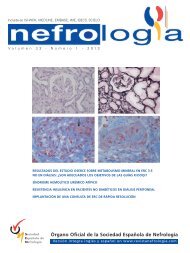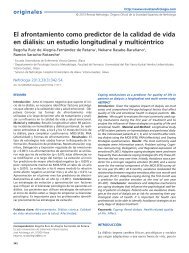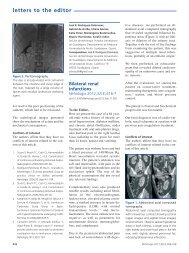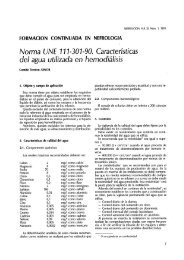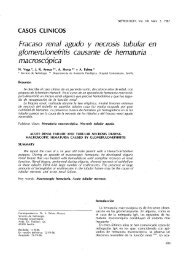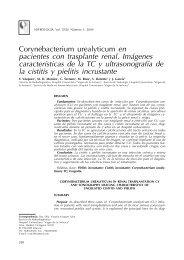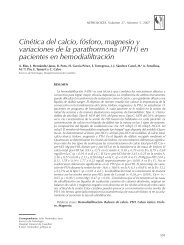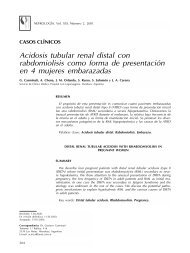PDF Número - NefrologÃa
PDF Número - NefrologÃa
PDF Número - NefrologÃa
Create successful ePaper yourself
Turn your PDF publications into a flip-book with our unique Google optimized e-Paper software.
G.M. London. Arterial calcification<br />
revisiones cortas<br />
associated with aging and arterial remodeling, including<br />
intima-media thickening, but also changes of the geometry<br />
and function of aortic valves, e.g., decreased aortic valve<br />
surface area and smaller valve opening 11 .<br />
MECHANISMS OF ARTERIAL CALCIFICATION<br />
The presence of dystrophic calcification in the arterial walls is<br />
a response to tissue injury, represents a repair process, and is a<br />
form of scar tissue 12 . Experimental and clinical studies have<br />
shown that AC is a process reflecting changes of the vascular<br />
smooth-muscle cells (VSMC) and pericytes from contractile to<br />
secretory phenotype). VSMC synthesize bone-associated<br />
proteins, including alkaline phosphatase, osteocalcin,<br />
osteopontin and a coat of collagen-rich extracellular matrix,<br />
and includes the formation of matrix vesicles, nodules and<br />
apoptotic bodies, which serve as initiation sites for apatite<br />
crystallization 13,14 .<br />
In vitro, VSMC differentiation towards osteoblast-like cells,<br />
with subsequent mineralization, is regulated by the balance<br />
between promoters and inhibitors of calcification, and<br />
results from disruption of this balance in favor of promoters.<br />
The secretory phenotype is initiated by the activation of<br />
Runx2 (Cbfa1) and osterix (Osx), transcrition factors that<br />
promote the differentiation of mesenchymal cells into the<br />
osteoblastic lineage 15,16 . The Runx2 and Osx are activated<br />
upstream by several factors including Msx2, Wnt and b-<br />
catenin signaling 17 . The stimuli initiating this “osteogenic<br />
cascade” include bone morphogenic proteins (BMP 2, 4)<br />
and chronic injurious stimuli and metabolic toxicities<br />
including generation of reactive oxygen species (ROS) 17-19 .<br />
The result could be either VSMC apoptosis or stimulation of<br />
NFk-B and activation of inflammatory mediators TNFa, IL-<br />
1, IL-6, and activation of macrophages 19-23 . Experimental<br />
studies using molecular imaging clearly showed that<br />
calcifications develops in parallel with inflammation in two<br />
phases: early activation of macrophages and inflammation<br />
and calcification at later stage 22 (figure 1).<br />
Pooled uremic serum with high phophate concentration,<br />
induced expression of Runx2 24 and blocks the expression of<br />
genes responsibles for expression of contractile molecules 13,14 .<br />
In vitro, the phosphate-stimulated calcification process can be<br />
inhibited by adding pyrophosphates that antagonize the<br />
cellular sodium-phosphate cotransport system (PIT-1) 25 .<br />
Recent study has shown tha phosphate induces the<br />
calcification process through a common pathway: increasing<br />
mitochondrial ROS and activation of NFk-B pathway and<br />
transcription of osteogenic program with expression of Msx2-<br />
Wnt-Runx2 26 .<br />
In the presence of normal serum, VSMC do not calcified and<br />
can inhibit spontaneous calcium and phosphate precipitation<br />
in solution, indicating that systemic calcification inhibitors<br />
Nefrologia 2011;31(6):644-7<br />
Abdominal aortic calcification<br />
score (kaupilla)<br />
24<br />
21<br />
18<br />
15<br />
12<br />
9<br />
6<br />
3<br />
hsC-RP (mg/L)<br />
Figure 1. Correlations between the abdominal aortic<br />
calcification score and high-sensitive C-RP.<br />
R =0.633<br />
p



